|
|
|
Sort Order |
|
|
|
Items / Page
|
|
|
|
|
|
|
| Srl | Item |
| 1 |
ID:
121399
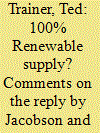

|
|
|
|
|
| Publication |
2013.
|
| Summary/Abstract |
I recently criticised the claim by Jacobson and Delucchi that renewable energy sources could meet world energy demand. Jacobson and Delucchi replied defending their position. This is a response to the main points made in that reply. The main issues are to do with intermittency of renewable energy sources and the implications for redundant plant and storage, vehicle to grid systems as a storage solution, the embodied energy costs of renewable energy, and overall system capital costs. It is argued that Jacobson and Delucchi do not provide satisfactory analyses of these issues and that they do not show that energy supply can be 100% renewable. This discussion is intended to clarify some of the core issues in the debate about the limits of renewable energy.
|
|
|
|
|
|
|
|
|
|
|
|
|
|
|
|
| 2 |
ID:
150913
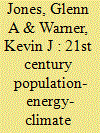

|
|
|
|
|
| Summary/Abstract |
World population is projected to reach 10.9 billion by 2100, yet nearly one-fifth of the world's current 7.2 billion live without access to electricity. Though universal energy access is desirable, a significant reduction in fossil fuel usage is required before mid-century if global warming is to be limited to <2 °C. Here we quantify the changes in the global energy mix necessary to address population and climate change under two energy-use scenarios, finding that renewable energy production (9% in 2014) must comprise 87–94% of global energy consumption by 2100. Our study suggests >50% renewable energy needs to occur by 2028 in a <2 °C warming scenario, but not until 2054 in an unconstrained energy use scenario. Given the required rate and magnitude of this transition to renewable energy, it is unlikely that the <2 °C goal can be met. Focus should be placed on expanding renewable energy as quickly as possible in order to limit warming to 2.5–3 °C.
|
|
|
|
|
|
|
|
|
|
|
|
|
|
|
|
| 3 |
ID:
141250
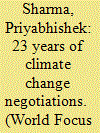

|
|
|
|
|
| Summary/Abstract |
Over the decades, climate change has emerged as an established wisdom of contemporary times. This has happened merely in the span of last three decades. Prior history of the science of climate change was full with controversy and debate. When at the turn of the nineteenth century the Swedish chemist Svante Arhenius (1896) proposed this hypothesis for the first time that man-induced carbon dioxide in the atmosphere of earth would lead to an increase in surface temperature through the greenhouse effect, not many took him seriously. To believe that the climate of earth was changing at a pace and scale far greater than the routine characteristic change forming part of the geological history of earth was too farfetched a contention at that time. For about next half a century as a result of some evidence it came generally to be agreed upon that some sort of climate change was happening but it still remained largely unclear whether this change had been happening in the direction of global cooling or that of global warming.
|
|
|
|
|
|
|
|
|
|
|
|
|
|
|
|
| 4 |
ID:
166319
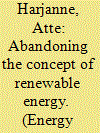

|
|
|
|
|
| Summary/Abstract |
Renewable energy is a widely used term that describes certain types of energy production. In politics, business and academia, renewable energy is often framed as the key solution to the global climate challenge. We, however, argue that the concept of renewable energy is problematic and should be abandoned in favor of more unambiguous conceptualization.
|
|
|
|
|
|
|
|
|
|
|
|
|
|
|
|
| 5 |
ID:
166317
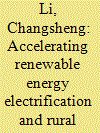

|
|
|
|
|
| Summary/Abstract |
The rural developing world faces a significant challenge in achieving the dual objectives of economic growth and decarbonization. An innovative business model tested in China that combines the use of solar photovoltaics (PVs) and agricultural greenhouses offers a solution to meeting this challenge and can have the potential for global deployment. However, the traditional PV-greenhouse business model is facing growing difficulties with shrinking revenues due to declining feed-in-tariffs. This study discusses a new business model concept based on a case in which a local Chinese PV company has transformed its business model from a crop production business to a service platform. The study concludes that business model innovation for expanding PV-greenhouse functions can help PV agricultural companies effectively adapt their businesses to policy changes and that new supporting policies are needed in promoting PV-greenhouse integration, adopting financial supporting measures, and facilitating grid integration of PV.
|
|
|
|
|
|
|
|
|
|
|
|
|
|
|
|
| 6 |
ID:
177143
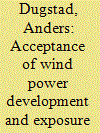

|
|
|
|
|
| Summary/Abstract |
Despite a large stated-preference (SP) literature on wind power externalities, few SP studies employ a case-control approach to examine whether people's acceptance of new wind power developments and renewable energy initiatives increases or decreases with exposure. Furthermore, the existing studies are inconclusive on this issue. In a case-control discrete choice experiment, we measure the level of acceptance in terms of people's willingness-to-accept (WTA) for having future land-based wind power developments in Norway; comparing exposed and non-exposed people's WTA. We find that exposure lowers acceptance. Furthermore, exposed people are also unwilling to pay as much to increase general domestic renewable energy production (from all sources) as non-exposed people, and thus have lower acceptance for such renewable energy policy initiatives. After testing for type of exposure, we argue that the inconclusiveness in the literature of how exposure affects acceptance of wind power developments could be due to the fact that impacts considered differ somewhat across studies.
|
|
|
|
|
|
|
|
|
|
|
|
|
|
|
|
| 7 |
ID:
171499


|
|
|
|
|
| Summary/Abstract |
This research centers around the question: How can provincial governments take the lead in implementing an adaptive governance approach considering citizen-led wind energy development? A framework for ‘accommodative leadership’ was created - building on the work of Meijerink and Stiller (2013) regarding leadership in climate change adaptation, and the work of Sotarauta (2010) on place leadership. The combination of the two provides a leadership framework which aims to include both governmental actors and local citizens initiatives as potential leaders in wind energy development.
Three cases studies in three regions of the Netherlands were assessed. The results show that provinces adopt various leadership styles, referred to as ‘facilitative decentralization’, ‘deliberative innovation’ and ‘authoritative reluctance’. Our conclusion is that there is no roadmap for effective accommodative leadership, as it occurs in many forms. Nonetheless the developed framework can be used by regional governments as an assessment tool to understand the roles and actions which can potentially be taken by this authority to purposefully allocate their leadership capacities, while allowing citizen-led wind energy development.
|
|
|
|
|
|
|
|
|
|
|
|
|
|
|
|
| 8 |
ID:
104821


|
|
|
| 9 |
ID:
191149
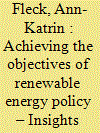

|
|
|
|
|
| Summary/Abstract |
Many countries choose policy objectives around their renewable energy expansion targets, such as efficiency and effectiveness. Due to the different nature and impact of those objectives, not all can be achieved simultaneously, so prioritising objectives is advisable. In this paper, we theoretically analyse the relationship between objectives and show that most European countries with renewable energy auctions in place have defined incoherent policy strategies in their respective renewable energy legislation. Based on these strategies, we analyse which objectives lead to the choice of which auction design elements conducting a qualitative comparative analysis. Considering 269 auction rounds from 20 European countries in the period 2011–2020, not all resulting choices of auction designs are in line with auction theory and existing literature’s findings on the relationship between objectives and auction design. Nevertheless, we show that on a country-level basis, most considered countries choose congruent auction designs, which either support all their (coherent) stated objectives or prioritise one or several of their incoherent objectives. For those countries with an incongruent auction design, we give recommendations on how to adapt their auction design depending on their exact choice of policy objectives.
|
|
|
|
|
|
|
|
|
|
|
|
|
|
|
|
| 10 |
ID:
176742
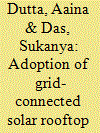

|
|
|
|
|
| Summary/Abstract |
Renewable energy is being seen as a transformative solution to meet energy as well as economic challenges at national as well as at a global level. The Government of India has expressed its intent to achieve 100 GW of solar capacity in the country by 2020. However, one such state that lags in harnessing and achieving the solar targets is the state of Jammu and Kashmir despite having the second highest potential of solar energy. Jammu and Kashmir is a power deficit state though it has one of the best potentials in solar energy. Solar rooftop PV systems can solve most of the problems regarding power deficit, but yet people are naïve about solar rooftop PV systems. The purpose of this study is to perform stakeholder analysis to investigate the perceptions of the groups/individuals regarding grid connected solar rooftop PV systems. They have a critical impact on the result of the study as they provide fundamental data on the political, social and economic scenario of any study area. The findings from the investigation underscores that all the projects and programs related to the adoption of a solar rooftop system should concentrate on building awareness.
|
|
|
|
|
|
|
|
|
|
|
|
|
|
|
|
| 11 |
ID:
151518
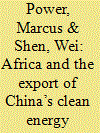

|
|
|
|
|
| Summary/Abstract |
The spectacular scale and speed of China’s domestic renewable energy capacity development and technology catch-up has in recent years been followed by the ‘go out’ of Chinese clean energy technology firms seeking new markets and opportunities in sub-Saharan Africa. This paper explores the growing involvement of China in the development and transfer of renewable energy technologies in Africa and examines the key drivers and obstacles shaping Chinese renewable energy investments and exports. Far from there being some kind of grand or harmonious strategy directed by a single monolithic state, we argue that fragmented and decentralised state apparatuses and quasi-market actors in China are increasingly pursuing their own independent interests and agendas around renewable energy in Africa in ways often marked by conflict, inconsistency and incoherence. Moving beyond the state-centric analysis common in much of the research on contemporary China–Africa relations, we examine the motivations of a range of non-state and quasi-state actors, as well their different perceptions and constructions of risk, policy environments and political stability in recipient countries. The paper explores the case study example of South Africa, where Chinese firms have become increasingly significant in the diffusion of renewable energy technology.
|
|
|
|
|
|
|
|
|
|
|
|
|
|
|
|
| 12 |
ID:
149841


|
|
|
|
|
| Summary/Abstract |
For many Small Island Developing States (SIDS) the cost of producing electricity from imported fossil fuels is so high and the cost of renewable energy technology has fallen so significantly that transitioning towards renewable energy is likely to produce cost savings. A recent workshop at NYU School of Law, which brought together SIDS utility representatives with a leading renewable energy developer and other stakeholders, provided strong support for this prediction. Utilities are likely to own the majority of renewable energy assets in SIDS and will therefore be the initial custodians of any cost savings renewable energy provides. This raises a key policy question: to what extent should SIDS utilities pass on these savings to consumers by lowering electricity rates? We analyze this overlooked element of energy policy and highlight undesirable consequences that complete disbursement of the savings to consumers could cause.
|
|
|
|
|
|
|
|
|
|
|
|
|
|
|
|
| 13 |
ID:
127934
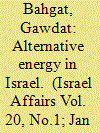

|
|
|
|
|
| Publication |
2014.
|
| Summary/Abstract |
Unlike other countries in the Middle East, Israel has limited hydrocarbon deposits. Since its founding in 1948 Israel has largely relied on foreign supplies to meet almost all its energy needs. In recent years substantial natural gas deposits have been discovered in the Eastern Mediterranean. These discoveries are likely to fundamentally improve the country's energy security. Equally important, Israel has invested massive efforts and resources to utilize the largely untapped solar and wind power. It has also considered initiating a nuclear power programme. Finally, efforts have been made to raise energy efficiency.
|
|
|
|
|
|
|
|
|
|
|
|
|
|
|
|
| 14 |
ID:
119664
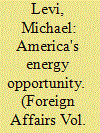

|
|
|
|
|
| Publication |
2013.
|
| Summary/Abstract |
The U.S. energy revolution is not confined to a single fuel or technology: oil and gas production, renewable energy, and fuel-efficient automobile technologies all show great promise. To best position the country for the future, U.S. leaders should capitalize on all these opportunities rather than pick a favorite; the answer lies in 'most of the above.'
|
|
|
|
|
|
|
|
|
|
|
|
|
|
|
|
| 15 |
ID:
098275
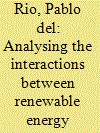

|
|
|
|
|
| Publication |
2010.
|
| Summary/Abstract |
CO2 emissions reduction, renewable energy deployment and energy efficiency are three main energy/environmental goals, particularly in Europe. Their relevance has led to the implementation of support schemes in these realms. Their coexistence may lead to overlaps, synergies and conflicts between them. The aim of this paper is to analyse the interactions between energy efficiency measures and renewable energy promotion, whereas previous analyses have focused on the interactions between emissions trading schemes (ETS) and energy efficiency measures and ETS and renewable energy promotion schemes. Furthermore, the analysis in this paper transcends the "certificate" debate (i.e., tradable green and white certificates) and considers other instruments, particularly feed-in tariffs for renewable electricity. The goal is to identify positive and negative interactions between energy efficiency and renewable electricity promotion and to assess whether the choice of specific instruments and design elements within those instruments affects the results of the interactions.
|
|
|
|
|
|
|
|
|
|
|
|
|
|
|
|
| 16 |
ID:
098582
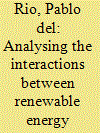

|
|
|
|
|
| Publication |
2010.
|
| Summary/Abstract |
CO2 emissions reduction, renewable energy deployment and energy efficiency are three main energy/environmental goals, particularly in Europe. Their relevance has led to the implementation of support schemes in these realms. Their coexistence may lead to overlaps, synergies and conflicts between them. The aim of this paper is to analyse the interactions between energy efficiency measures and renewable energy promotion, whereas previous analyses have focused on the interactions between emissions trading schemes (ETS) and energy efficiency measures and ETS and renewable energy promotion schemes. Furthermore, the analysis in this paper transcends the "certificate" debate (i.e., tradable green and white certificates) and considers other instruments, particularly feed-in tariffs for renewable electricity. The goal is to identify positive and negative interactions between energy efficiency and renewable electricity promotion and to assess whether the choice of specific instruments and design elements within those instruments affects the results of the interactions.
|
|
|
|
|
|
|
|
|
|
|
|
|
|
|
|
| 17 |
ID:
125729


|
|
|
|
|
| Publication |
2013.
|
| Summary/Abstract |
In 2001, Australia introduced legislation requiring investment in new renewable electricity generating capacity. The legislation was significantly expanded in 2009 to give effect to a 20% Renewable Energy Target (RET). Importantly, the policy was introduced with bipartisan support and is consistent with global policy trends. In this article, we examine the history of the policy and establish that the 'stop/start' nature of renewable policy development has resulted in investors withholding new capital until greater certainty is provided. We utilise the methodology from Simshauser and Nelson (2012) to examine whether capital market efficiency losses would occur under certain policy scenarios. The results show that electricity costs would increase by between $51 million and $119 million if the large-scale RET is abandoned even after accounting for avoided renewable costs. Our conclusions are clear: we find that policymakers should be guided by a high level public policy principle in relation to large-scale renewable energy policy: constant review is not reform.
|
|
|
|
|
|
|
|
|
|
|
|
|
|
|
|
| 18 |
ID:
094259
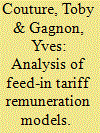

|
|
|
|
|
| Publication |
2010.
|
| Summary/Abstract |
Recent experience from around the world suggests that feed-in tariffs (FITs) are the most effective policy to encourage the rapid and sustained deployment of renewable energy. There are several different ways to structure a FIT policy, each with its own strengths and weaknesses. This paper presents an overview of seven different ways to structure the remuneration of a FIT policy, divided into two broad categories: those in which remuneration is dependent on the electricity price, and those that remain independent from it. This paper examines the advantages and disadvantages of these different FIT models, and concludes with an analysis of these design options, with a focus on their
|
|
|
|
|
|
|
|
|
|
|
|
|
|
|
|
| 19 |
ID:
117244
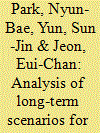

|
|
|
|
|
| Publication |
2013.
|
| Summary/Abstract |
This paper analyzes the energy, environmental and economic influences of three electricity scenarios in Korea by 2050 using the "Long-range Energy Alternatives Planning system" (LEAP) model. The reference year was 2008. Scenarios include the baseline (BL), new governmental policy (GP) and sustainable society (SS) scenarios. The growth rate of electricity demand in the GP scenario was higher than that of the BL scenario while the growth rate in the SS scenario was lower than that of the BL scenario.
Greenhouse gas emissions from electricity generation in 2050 in the BL and GP scenarios were similar with current emissions. However, emissions in 2050 in the SS scenario were about 80% lower than emissions in 2008, because of the expansion of renewable electricity in spite of the phase-out of nuclear energy.
While nuclear and coal-fired power plants accounted for most of the electricity generated in the BL and GP scenarios in 2050, the SS scenario projected that renewable energy would generate the most electricity in 2050. It was found that the discounted cumulative costs from 2009 to 2050 in the SS scenario would be 20 and 10% higher than that of the BL and GP scenarios, respectively.
|
|
|
|
|
|
|
|
|
|
|
|
|
|
|
|
| 20 |
ID:
176862
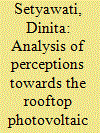

|
|
|
|
|
| Summary/Abstract |
In 2018, the Indonesian government issued the Rooftop Photovoltaic Solar Systems (RPVSS) policy that allows customers of the State Electricity Company (PLN) to generate their own electricity supply from solar photovoltaic (PV) systems and export surplus electricity to the national grid, valued at 65% of the full retail tariff. This policy is an effort to increase renewable energy levels in the national energy mix by 23% by 2025. Customer adoption of PV systems relies on the perceptions and perceived benefits of the technology, as well as general issues of confidence in the product. This paper explores the public's acceptance of the RPVSS policy from multiple perspectives. An online survey of PLN customers (n = 987) indicated consumer issues in adopting PV systems, such as high capital costs, long term return on investment and lack of information, as well as institutional issues such as the limited role of PLN and the absence of government financing mechanisms. Additional interviews with the government, private sector and energy experts identify the export rate for electricity injected into the grid as the main barrier to attracting prospective users. This paper's findings provide useful recommendations for policymakers to successfully implement the policy and increase solar energy deployment.
|
|
|
|
|
|
|
|
|
|
|
|
|
|
|
|
|
|
|
|
|